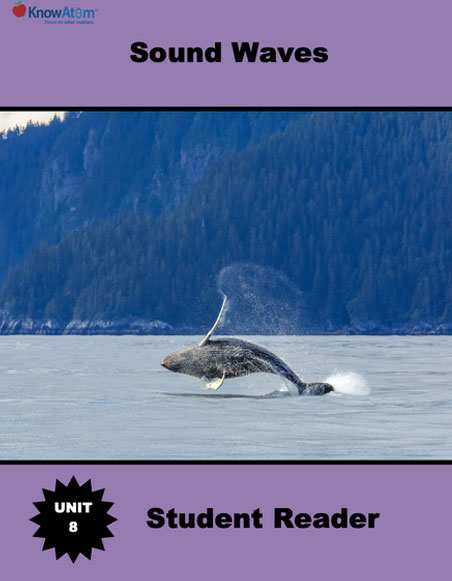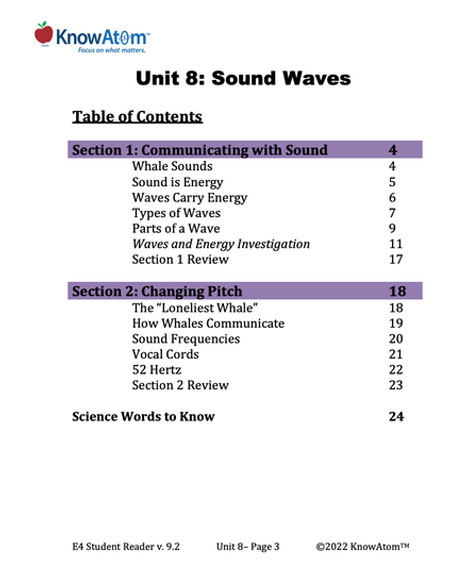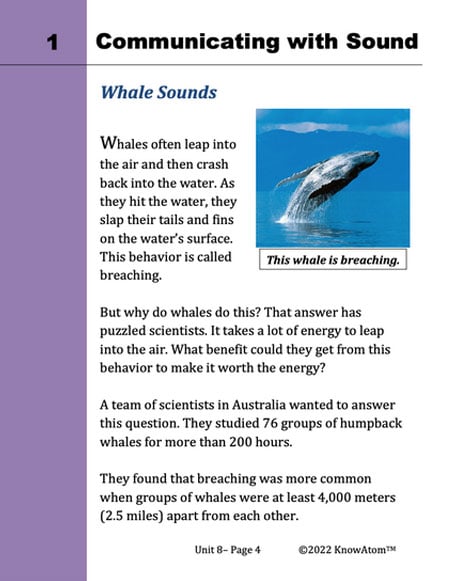In this lesson, students explore wave properties and how waves transfer energy by observing mechanical waves in water and modeling transverse and longitudinal sound waves in slinky springs.
In this unit, students explore the science phenomena of how energy can be transferred from one place to another. Students develop and use models of transverse and longitudinal waves in this lesson. This page showcases key components of this lesson.
Science background provides teachers with more in-depth information about the phenomena students explore in this unit on sound waves. Here is an excerpt of the background information on waves and energy.
Because waves transfer energy, they require a source since energy cannot be created or destroyed. Raindrops falling on a still lake are a good illustration of this. When the raindrops hit the water’s surface, they transfer their kinetic energy to the water. This creates water waves that carry that energy as they ripple outward. Once the ripples die down, the water returns to the same position.
Scientists classify waves according to how the disturbance moves relative to the wave itself. In some kinds of waves, the disturbance moves perpendicular to the direction of the wave itself. In other words, if the wave moves from left to right, the disturbance moves up and down. This kind of wave is called a transverse wave. When raindrops fall on the water, they hit the water vertically, while the wave moves horizontally. (Water waves also move in a longitudinal motion, which we’ll explore next, so they are categorized as their own kind of wave.)
When a crowd of people in a stadium do “the wave,” they are modeling a transverse wave. The individual people move up and down, while the wave moves from left to right (or right to left). This is an example of how waves move energy, not matter. After the disturbance passes through, the people go back to where they were before the wave moved through.
Sound waves move differently. Sound waves are patterns of vibrating molecules caused by the movement of sound through a medium. They are a type of wave called a longitudinal wave, in which the disturbance moves parallel to the direction of the wave itself. If the wave moves from left to right, the disturbance also moves from left to right.
As sound waves move through a medium, the molecules of the medium collide with one another in the same direction the sound wave is moving.
Think again of the sounds made by a breaching whale. When the whale crashes into the water, it transfers kinetic energy from its moving body to the surface of the water. This makes the molecules of water begin to vibrate and bump into the molecules closest to them. This passes on the energy and makes them vibrate too. Then those molecules bump into more particles, and so on.
As the sound wave moves from left to right through the water, the water molecules also vibrate to the right and left as the energy of the sound wave passes through it. If another whale is in the range of these vibrating molecules, it will hear the vibrations as sound.
As sound energy moves through matter, it causes molecules to press together. This is called compression. When this happens, the molecules on either side of the compression spread out. This is called rarefaction.
How compressed the molecules become as the sound wave moves through determines the wave’s amplitude. Amplitude is a measure of the wave’s displacement from its resting position. Displacement refers to the movement of a substance from its resting position. A water wave’s amplitude is its height above the water’s surface. A sound wave’s amplitude is the amount of compression that occurs as it moves through the medium.
The larger the force that causes the disturbance, the greater a wave’s amplitude will be. Because of this, amplitude is closely related to the amount of energy a wave carries. The greater the amplitude of a wave, the more energy it is carrying.
In sound waves, the amplitude of a wave also determines the sound’s volume, which is how loud or soft a sound seems. For example, the scientists who studied the behaviors of humpback whales believe that whales breach to produce loud sounds that can travel long distances through the water by creating a large disturbance that carries more energy, similar to how a drum makes sounds that can be heard from far away.
The wavelength is the distance spanned by one cycle of the motion of the wave. In longitudinal waves, it is the distance from one compression to the next or from one rarefaction to the next. In transverse waves, it is the distance from crest to crest (the top of the wave) or from trough to trough (the bottom of the wave).
In this lesson, students explore wave properties and how waves transfer energy by observing mechanical waves in water and modeling transverse and longitudinal sound waves in slinky springs.

Prepared hands-on materials, full year grade-specific curriculum, and personalized live professional development designed to support mastery of current state science standards.
Amplitude: a measure of the wave’s displacement from its resting position
Sound: energy that is carried in waves by vibrating molecules
Sound wave: a pattern of vibrating molecules caused by the movement of sound through a medium
Vibrate: to move back and forth quickly
Wavelength: the distance spanned by one cycle of the motion of a wave

Whale Sounds
Whales often leap into the air and then crash back into the water. As they hit the water, they slap their tails and fins on the water’s surface. This behavior is called breaching.
But why do whales do this? That answer has puzzled scientists. It takes a lot of energy to leap into the air. What benefit could they get from this behavior to make it worth the energy?
A team of scientists in Australia wanted to answer this question. They studied 76 groups of humpback whales for more than 200 hours.
They found that breaching was more common when groups of whales were at least 4,000 meters (2.5 miles) apart from each other.
Sound is Energy
The scientists believe the whales breach to communicate over long distances. Crashing into the water produces loud sounds. This is similar to how a drum makes sounds that can be heard from far away.
Understanding how this can happen begins with a basic look at what sound is. Sound is energy that is carried in waves by vibrating molecules. To vibrate means to move back and forth quickly.
When a whale crashes into the water, it transfers kinetic energy from its moving body to the surface of the water. This makes the molecules of water begin to vibrate. They bump into the molecules closest to them. This passes on the energy. Those molecules also begin to vibrate. Then those molecules bump into more particles, and so on. Particles stop vibrating once they have passed on the energy.


Waves Carry Energy
Sound energy moves from one place to another in waves. There are many different kinds of waves. Think of raindrops falling on a still lake. The kinetic energy of the falling rain transfers to the water. This creates water waves. The water waves carry that energy as they ripple outward. Once the ripples die down, the water returns to the same position.
All waves carry energy from one location to another location. Many waves are caused by a disturbance that travels through a medium. A medium is matter that a wave travels through. A whale crashing into the water is one source of a disturbance. Raindrops falling on a lake are another source of a disturbance.
In this lesson, students explore wave properties and how waves transfer energy by observing mechanical waves in water and transverse and longitudinal sound waves in slinky springs. Student teams carry out a three-part investigation into the phenomena of wave energy transfer in which they figure out the relationship between the amount of force applied in the initial disturbance and the resulting amplitude of the wave. Students use the data they gather from their experiments to explain how waves transfer energy, and how their models can be used to explain how sound moves in waves through a medium.
KnowAtom incorporates formative and summative assessments designed to make students thinking visible for deeper student-centered learning.

Standards citation: NGSS Lead States. 2013. Next Generation Science Standards: For States, By States. Washington, DC: The National Academies Press. Neither WestEd nor the lead states and partners that developed the Next Generation Science Standards were involved in the production of this product, and do not endorse it.
